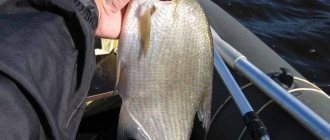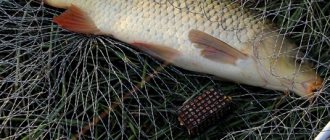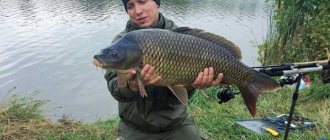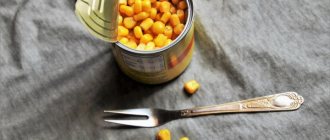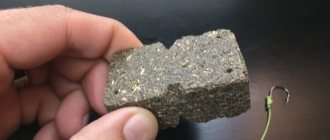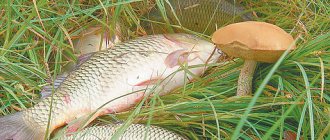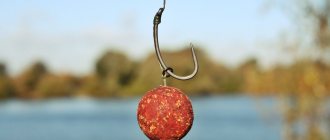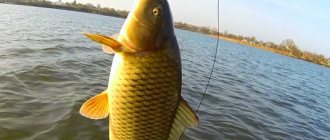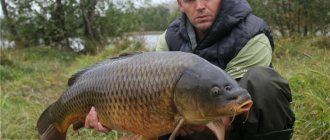“Tackle for catching carp from the shore.” Carp is a desired trophy for any angler. Being a close relative of the carp, this wild river fish is incredibly strong and wary, making it much more difficult and therefore more interesting to catch.
The population of carp in our rivers has decreased significantly over the past decades. But you can count on catching this fish. The main thing is to choose the fishing spot wisely, select the “right” gear for carp and serve it with a feeder such a treat that it simply cannot refuse.
Gear for catching carp from the shore: what do you need to know?
In winter, river bogatyrs (as carp are often called) slide into deep holes, where they wait for spring in a “reduced energy consumption mode.”
Shortly after the ice melts, when the water begins to warm up under the warm spring rays of the sun, the carp leaves its wintering pits and begins to move around the reservoir in search of food.
At this time, the carp feeds on both plant and animal foods. As the water warms up and algae grows, the carp becomes more and more active.
His real feeding begins in the first month of summer, before spawning, when the water warms up to 18-20 degrees. This is the best time to catch carp.
After spawning, fish activity drops significantly, which makes it difficult to catch carp. Therefore, if you want to purposefully hunt for this fish, devote time to hunting for the river hero from mid-May to mid-June.
Where to look for carp on the river
A large representative of the freshwater ichthyofauna, as befits a serious fish, loves spacious water areas. Most often, carp lives in medium and large rivers, as well as in reservoirs formed by these water arteries. The habitat of the wild ancestor of the carp is quite extensive. It is found in the basins of the Black and Caspian seas, water areas of the Azov and Aral seas. The carp is found in Far Eastern rivers flowing into the Pacific Ocean, as well as in Lake Issyk-Kul. Carp is quite demanding on water quality, for example, the oxygen content must exceed 7 mg/l. This fish also loves warm water, so you can only hunt for a trophy during the open water season. 1. In spring, fishing for carp on rivers begins before spawning. During this period, the fish is already recovering from winter and begins to regain its strength. As soon as the water temperature approaches +15°C, the fish, as if on command, enter shallow bays rich in dead vegetation. For mating games, this large representative of the carp family chooses the coastal waters that are most overgrown with grass. In the middle zone, spawning begins at the end of April or in May, which depends on the vagaries of the weather. Beginner fishermen are especially excited on a quiet evening, when large individuals begin to frolic near the shore. When you see such prey, your hands involuntarily grab the landing net. It is important! However, trying to catch fish in this way is futile and despicable. After all, only one female is capable of laying up to 1.5 million eggs, some of which can subsequently turn into giant fish. 2. In summer, the carp becomes more capricious; it switches to plant food, gnawing large quantities of young shoots of aquatic plants. On hot days, the fish hides in snags, under steep banks or at great depths. It becomes impossible to get to it without a boat. 3. Autumn is considered one of the best times of the year for hunting wild carp. Starting from mid-September, the fish switches to active feeding. Gradually moving towards wintering areas, a natural concentration of a large number of carp occurs. During the feeding season, confident bites follow one after another. Even with cliffs and noisy fishing, the remaining members of the flock do not leave the feeding place, greedily absorbing both groundbait and bait.
Gear for catching carp from the shore - fishing location
80% of success when catching carp from the shore depends on how well the fishing spot is chosen. Carp prefers to stay in places with a depth of at least 3-4 meters, but goes out to feed in shallow waters abounding in underwater vegetation.
The fisherman’s task is to find a place on the river where the shallows meet the depths. If such a place is found, you can count on a carp bite. The figure below, as an example, shows a section of the river where there are promising parking spots for carp.

Places for catching carp
You can often see carp cruising imposingly near the surface of the water in bays and oxbow lakes of rivers. Sometimes, river heroes even jump out of the water, creating a splash that can be heard many hundreds of meters away.
Because of this, many anglers believe that carp feed in the upper layers of water. This opinion is false, because this fish feeds exclusively at the bottom. So you need to catch carp on a donk.
Selection of bait and attachments for catching carp
In the summer, after the water has subsided and until mid-August, in order not to attract the attention of small things, we use bait that quickly sinks to the bottom and creates little turbidity. These are mainly steamed split peas, pearl barley, chickpeas and corn with the addition of attractants. I prefer to use garlic and anise drops. At this time, we use steamed peas and hand-made boilies with a diameter of 7 to 12 mm from semolina and pea puree as bait. The attractants are the same as for bait. Other baits are constantly eaten by small fish during the summer period. From mid-August until almost freeze-up, when the pressure from small fish decreases, we use various commercially produced bait mixtures that create a large cloud of turbidity. Effective, for example, carp mixtures produced by. We definitely add steamed peas or corn to them. We add a little attractants or do without them altogether. For bait we use dung worms, pearl barley, peas, snails, shells and canned sweet corn. For some unknown reason, carp prefers corn, and ignores the products of other companies. With the onset of cold weather, the carp becomes more capricious in its choice of food, you have to experiment with bait, make “sandwiches” from various baits, for example: mobile with corn, or a small piece of shell with peas, or a couple of grains with a snail.
There can be many options. It is best to go fishing with an overnight stay. And not just for the sake of sitting by the fire and eating sweet, fragrant fish soup, although this is also important. The main thing is to feed in the evening in the most promising places. You will need a lot of bait, about 10-15 kg for two or three places. Of course, it is better to feed for several days in a row, training the carp to one place. Before dark, we place marking buoys and scatter bait between them. The most important thing is to do it before dark. One day, having arrived at the place quite late, we first set up a tent, prepared dinner, and only after that fed it. They did this in the dark. We knew the place thoroughly, we weren’t afraid to make a mistake, but the next morning it turned out that the bait had been scattered in completely different places. With the onset of dawn, when we went out on the water, we could not find the marking buoys in the usual places and we were all perplexed. where are they before the fog clears? The buoys turned out to be located tens of meters from the desired locations. The bait was wasted. I want to emphasize that we feed two or three places at once, since often only one of them “works”. And there are times when, after catching a couple of carp or after leaving, the fish completely refuses to bite, then you have to change the place. This is how we swim during fishing, constantly changing our location, giving places a “rest.” Not forgetting, of course, to feed them when changing. While fishing, feed the area with balls the size of tennis balls every twenty minutes, trying to create a path of bait. If we fish from a boat together, we try to ensure that the boundaries of our fishing gear are as close to each other as possible. We make the wiring at a distance no more than twice the length of the rod. We do not use wiring with a long float release. Firstly, feeding from a long distance is quite problematic. Secondly, the bottom topography is not always the same. Thirdly, catching carp from a long distance is much more difficult. And the most important thing is that during a long-distance vacation you can no longer talk about classic wiring; other gear and other skills are needed here. We usually fish from inflatable boats to create less noise. It is advisable to have two people in the boat, since when fishing for large specimens, the help of a friend is often necessary. A standard bite for carp looks like this: the float is confidently submerged two or three times, then dives under the water or. gradually going deeper it goes to the side. But sometimes the carp bites sluggishly, the float twitches a little and stops, or very slowly goes under the water, as if hooked. In such cases, it is also worth cutting. As soon as you feel some kind of heaviness at the other end of the fishing line, do not hesitate - there are a couple of seconds until the carp understands what happened to it. During this short time, you need to try to lift him as high as possible or pull him away from the writhing. This gives you more chances to win. Then the carp begins to actively resist and performs all its tricks. Here the chances of winning are equal.
Tackle
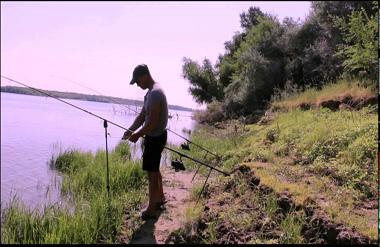
In terms of resistance during fishing, carp cannot be compared with it. Wild fish is wild fish... Therefore, if you want to not only hook a carp, but also put it in a landing net, you need to assemble a donk based on a powerful rod.
You can also use a regular snack, but this is by no means the best option. Often you have to fish at a great distance from the shore, where you simply cannot throw the equipment by hand.
As a tackle for catching carp from the shore, it is best to use special carp spinning rods. They are very clear, powerful, and with them you will feel confident even when fighting a giant carp.
An alternative to carp gear is an extra heavy class feeder, with a test weight of more than 200 grams, and a spinning reel with a spool size of more than 5000 according to the Shimano classification. A long, powerful feeder will also easily withstand a confrontation with a river hero.
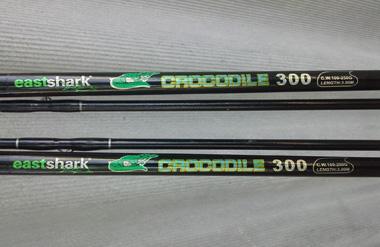
If professional equipment for catching carp is too expensive, you can assemble the equipment based on a powerful fiberglass Chinese spinning rod.
Krokodile rods have proven themselves very well. At a meager cost, they have strength and power that any feeder or professional carp spinning rod can envy.
The model range of "Crocodiles" is very wide. For fishing from the shore, rods with a length of 2.6-3 m and a weight of more than 200 grams are best suited. This spinning rod will allow you to work even with a very heavy feeder, which is important when fishing in the current.
If the budget for purchasing a reel is very limited, I do not recommend buying the cheapest feeder or carp reels made in China. It’s better to put a regular inertial “Nevskaya” on the spinning rod. It has good traction force and will not let you down at a crucial moment.
When fishing for carp, it is advisable to use a braided cord, because it has a good margin of safety. The most budget-friendly, but by no means the worst option is Power Pro braid.
The optimal diameter is 0.2-0.25 mm. A thinner cord can be broken by a carp. There is simply no need for a larger diameter cord.
Feeder tackle equipment
Catching carp on a feeder is more effective with long casts. Thanks to the presence of a feeder, there is a greater chance of attracting the desired prey. The feeder is attached in various ways; there are a number of widely used techniques. There is no need to reinvent the wheel, just use one of the options.
Gardner's Paternoster
The Gardner loop is the most common and simple method, but it has a drawback - the paternoster does not have a self-cutting function. It is convenient to use when there is an abundance of silt at the bottom of the reservoir. Often the feeder and bottom of the carp become somewhat silted, this is not a problem, the carp will find the feeder by the protruding element.
The sensitivity of the equipment allows you to respond to any additional load, even weak suction of the bait. The feeder is attached to a 15 cm long twist, this prevents the line from overlapping with the main cord and the feeder.
Inline
The method is effective, simple and popular. It is based on a sliding sinker, which can be easily removed and replaced with a feeder. The disadvantage of this method is that it is not used at great depths and with heavy feeders.
Read more
How to catch pike perch in winter using hooks?
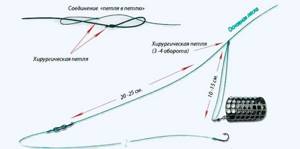
Fishermen can make some types of rigs on their own, using available materials and a minimum of funds.
Helicopter and two knots
The “helicopter” tackle is a self-cutting variety that is best used on rivers with medium flow speeds. The bait is attached to an extended leash. Often the distance between the feeder and the tackle reaches 1 m. Due to the water flow, the “helicopter” hovers in the water below the surface; to obtain the described result, the rod is placed at an angle of 45° to the current.
Symmetrical loop
It belongs to the self-cutting group of equipment. Its advantage is good sensitivity; it transmits bites of any intensity. Even moving to the side, the prey creates vibrations that are noticeable to the fisherman. Usually used in calm water, where there is no current at all.
Asymmetrical loop
The asymmetrical loop is an improved version of the symmetrical method. It is suitable for use on rivers even with intense currents. The special design prevents the main cord from twisting with the leash.
Tube with anti-twist
The anti-twist for the feeder is bent in 2/5 parts, and the feeder is mounted directly on the bend.
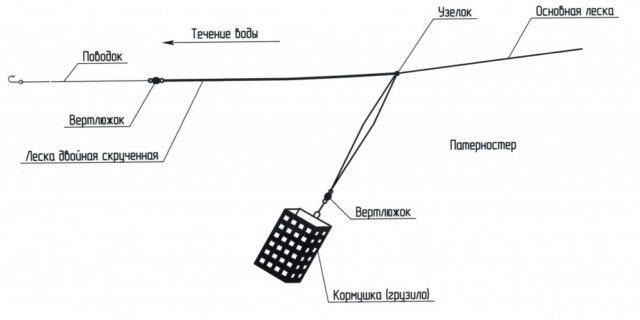
To make the tackle, a feeder is tied to the end of the main line, to which, in turn, leashes are tied
Snaps
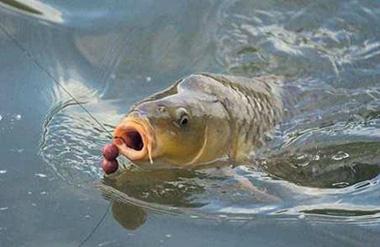
As I already said, carp feeds in the lower layers of water. With its large mouth, like a vacuum cleaner, it sucks up particles of food from the bottom.
Therefore, for catching carp, boilies are used, as well as non-sporting nipple rigs, or “makushatniks”.
Catching carp with boilies is more sporting and interesting, but, unfortunately, not budget-friendly. A rig with a maw feeder is also very effective, but is considered an amateur (“old-fashioned”) method.
But fishing with tackle and a feeder is affordable for everyone. Below, I will talk in detail about how to make equipment for fishing with boilies and cake (makukha). The choice is yours.
What types of equipment are used

The equipment for carp, and in particular its formation and principle of operation, depend on a number of factors arising from the physiological characteristics of the fish, its habitat and preferences in the choice of nutritional objects. It is worth noting that carp are quite powerful and fast fish, capable of crushing even the most reliable tackle with poor handling technique. At the same time, the fish is very careful and timid, which is why it tries to stay at long distances from coastlines.
The carp prefers to inhabit snags and driftwood, as well as bottom topography with holes, adhering to moderate currents. It feeds mainly on muddy bottoms, as well as on shell rocks and shallow waters with young aquatic growth. The food supply consists of plant and animal food. The plant diet includes cereal seeds, as well as berries that fall into the water. Carp love young shoots of cattails and reeds.
Animal food consists of all kinds of insect larvae developing in the water, as well as mayflies, mollusks, especially zebra mussels, leeches, molting crayfish, fish eggs and the juvenile fish themselves. The use of high reliability parameters for tackle cords is greatly influenced by the presence of a file on the front ray of the upper fin of the fish, which often causes cut-offs of equipment when fighting hooked fish.
Based on all the features presented above, carp fishing relies on bottom rigs for long-distance fishing strategies and float rods, mainly fly rods, if fishing is planned to be done from a boat or a cliff hanging over a reservoir. Fishermen use both universal purchased and homemade gear, tailored specifically for carp.
Feeder tackle
The feeder belongs to the bottom type of equipment, combining two important features that help catch carp - the ability to fish at long distances, over 100 meters, while simultaneously forming a feeding table that attracts fish. The feeder fishing rod for carp is distinguished by a length parameter starting from 3.5 meters and above, as well as a large dough, selected from 80 grams. The medium action of the blank, shifted towards the slow one, helps to effectively fight with already caught fish and notice its careful bite.
A spinning reel is selected under the rod with the obligatory presence of a baitrunner and a safety cable on the butt of the tackle. The device size is at least 3500–4000 units. The spool should hold about 200 meters of 0.25 mm braided cord. The power and traction mechanism covers the harsh conditions of carp fishing.
Shock leaders and ties are used in the rigging of the lines, allowing you to feel subtle bites in current conditions. The use of feeders varies from classic metal or plastic meshes to method and spring options. A thin braided leash with a length of 20 to 40 cm is placed on the feeder, equipped with a hook number 8–10.
We invite you to familiarize yourself with the onboard fishing rod for carp
Bottom gear for catching large carp is assembled according to the principle of carp equipment, which is based on replacing the feeder with a blind sinker, which allows the fish that takes the bait to self-hook. Such installations are completed on specialized carp rods or spinning rods with large tests. The rod is equipped with carp low-speed spinning reels equipped with a braided cord having a high breaking load.
Often, in this type of equipment, hair equipment is used, when installing gear for fishing with corn or boilies. When a fish tries the bait, it hooks itself. The bite is controlled by various signaling devices based on the principle of operation. The signaling device can be either a regular bell or an electronic light and sound system with a pager. Carp equipment is convenient for fishing with several rods at the same time at any time of the day.
Equipment for catching carp in the current should hold the bait in the bottom layer. The river piglet sucks up food from the bottom with its mouth, like a vacuum cleaner. Sometimes a fish manages to dig up a shell hidden in the ground up to 20 cm deep. However, when installing equipment, you should not focus on sensitivity and elegance.
Only the strength of the structure will be the main criterion during installation.• Of the many feeder equipment, you should choose the paternoster. The design is based on the main fishing line, it is simple and quick to do. First, a swivel with a snap hook is attached to the main fishing line. Then, measuring 30-40 cm from the end, the thread is folded in half.
The swivel should be on the resulting loop. A surgical loop is made 10-15 cm from the swivel. At the resulting end of the 20-25 cm fishing line, a knotted loop is knitted, to which the leash will be attached. A feeder is attached to the carabiner while fishing. In the case of a side fishing rod, instead of a feeder, a sinker with a flat shape is mounted.
• “Nipple” is a feeder to which leashes with hooks (3-4 pcs.) are attached. The “nipple” can be made of polyethylene cork, wire twisted into a spring, concave lead plates, etc. Most often, leashes are made of soft fishing line or braid. Any model No. 5-8 is suitable as a hook for carp.
• “Makushatnik” is a tool that is adjusted to fit rectangular pressed sunflower cake. The basis of the “makushatnik” is a lead plate or casting, the dimensions of which are comparable to a matchbox. Holes are made in the corners of the plate for mounting leads. Before laying the pressed cube, transverse and end cuts are made on it.
A longitudinal slot is needed for tying to a sinker with a thread, and hooks are hidden in the end grooves. • There is also no point in making too elegant equipment for a float fishing rod. A large carp in an instant drags the float under the water. For fishing from a boat, it is enough to choose a river float model with a carrying capacity of 3-5 g.
A sinker weighing 3-5 g is mounted on the main fishing line. It should completely submerge the body of the float. A feeder in the form of a pellet of 0.2-0.5 g is attached to a leash. During retrieval, the fisherman must cling to the bottom, slowing down the floating bait. To hunt for freshwater piglet, the fisherman has a fairly wide choice of fishing methods.
Hair installation for using boilies
Boilies are not put on the hook tip, but are connected to it with a special leash, which is called a “hair” (in the first rigs of this type, the bait was tied to the hook with a hairline). The carp, sucking the bait, swallows the hook.
When a foreign, inedible body ends up in his mouth, he tries to spit it out while holding the nozzle. The sting, directed outward, digs into the lower lip of the fish, and the carp ends up on the hook.
To make hair accessories you will need:
- braided driving material;
- hook;
- stopper;
- swivel;
- winding ring;
- sliding carp sinker.
Manufacturing:
- First you need to put a sliding sinker on the main line. Attach a swivel to the end of the cord. This will be the basis of our equipment.
- Now we take the leader material and remove 12-15 cm of the braid.
- At the end of the braid we make a small loop (Fig. 1). We cut off the excess (Fig. 2).

Rice. 1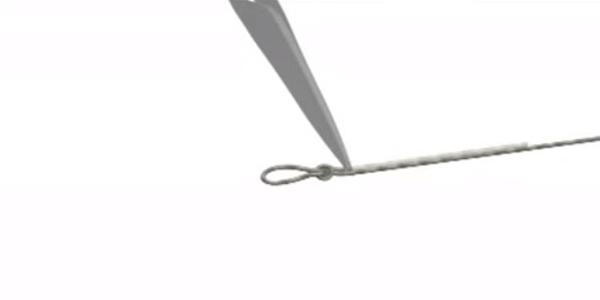
Rice. 2 - We put a hook on the leash through the free end as shown in Fig. 3 (it is important that the hook is directed towards the free end).
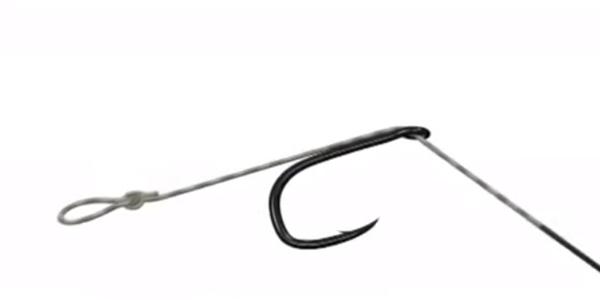
Rice. 3 - We measure the required length of the leash (3-5 cm), and fix the hook with a knotless knot (Fig. 4,5,6).
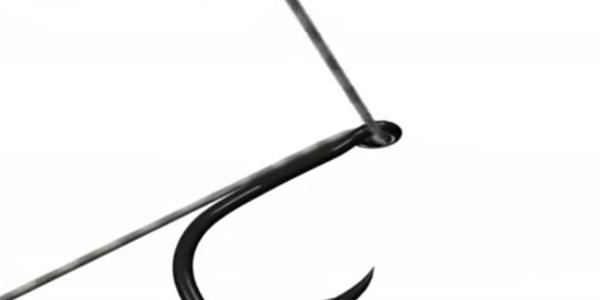
Rice. 4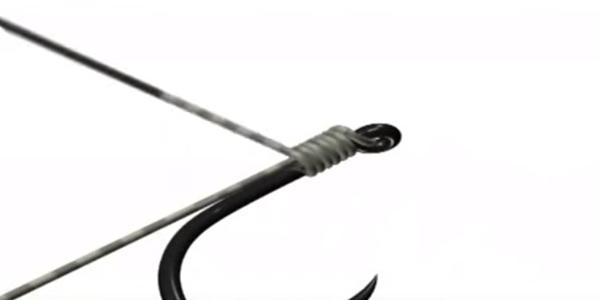
Rice. 5
Rice. 6 - We tie the free end of the leash to the winding ring (Fig. 7). We connect the winding ring to the swivel at the end of the main cord (Fig. 8).

Rice. 7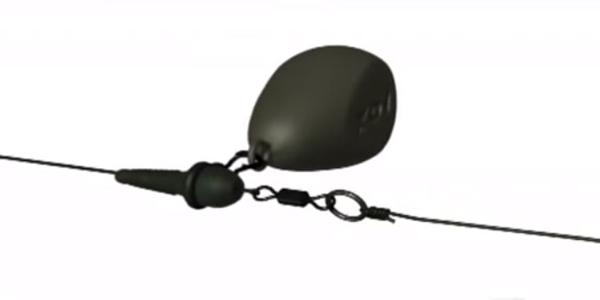
Rice. 8 - The equipment is ready. Using a special needle for boilies, we drag the “hair” through the bait (Fig. 9), and fix it with a special silicone stopper (Fig. 10).
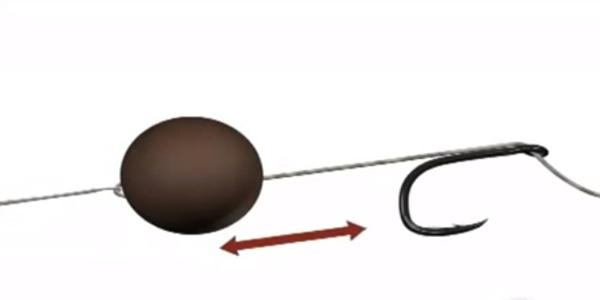
Rice. 9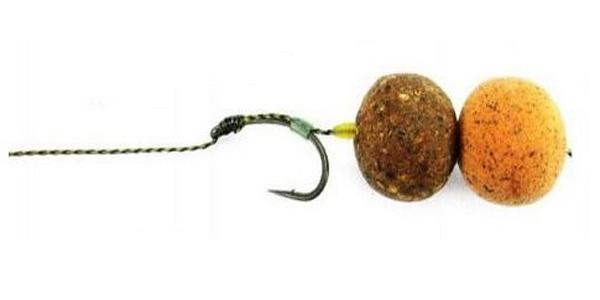
Rice. 10
Lure
Without effective attachment with feeding compounds, catching carp becomes quite difficult and, in most cases, futile. Despite its natural gluttony, the fish is selective in its taste preferences, which vary from body of water to body of water with their own nuances.

Throughout the established practice of feeder hunting for this subspecies of carp, fishermen have selected universal bases of feeding mixtures, the addition of a certain type of attractant to which contributes to the success of fishing. The basis of feeding is made from a brew of millet or barley porridge, adding fish feed and sweet breadcrumbs to the mixture. The prepared porridge is not decanted, leaving the broth as an element that glues the components together.
The balls supplied to the fishing zone must quickly reach the bottom and remain in a dense state for some time, only creating a trail of turbidity. The turbidity plume is provided by adding powdered milk or raw semolina to mixed mixtures. Soils containing clay serve as weighting agents and thinners. Vegetable ingredients in the form of sweet canned corn, crushed boiled potatoes and peas are combined with an animal base, mixing chopped worms, crushed bloodworms and canned maggots in mixed mixtures.
Important! The pulp of crushed shells living in the fishing zone contributes to the rapid approach of fish to the feeding point.
Attractants for tackle charged with the bait described above can be vanilla, cinnamon, honey and strawberry essence. Carp are responsive to sweet tastes, and in some reservoirs the smells of banana, chicory and the mixed attractant tutti-frutti can become fishing hits.
Makushatnik for fishing
A long time ago, fishermen noticed that carp really like the taste and smell of sunflower cake. To this day, makukha is one of the best baits for carp. It is best to catch river bogatyr using pressed cake.
The equipment works by suction: the hooks are hidden in a piece of makushka (it essentially serves as a feeder), and when the carp begins to suck the cake, along with edible particles, sharp hooks get into its mouth, and when it tries to get rid of them, the mouthpiece is cut off by itself.
To make equipment for cake fishing, you will need:
- flat rectangular sinker;
- cord, diameter 0.2-0.23 mm;
- carp hooks;
- silicone stoppers;
- pressed cake.
Manufacturing process:
- We take a flat sinker (Fig. 1) and make two through diagonal holes at its ends. They can be made with a thin drill, 2 mm in diameter (Fig. 2).
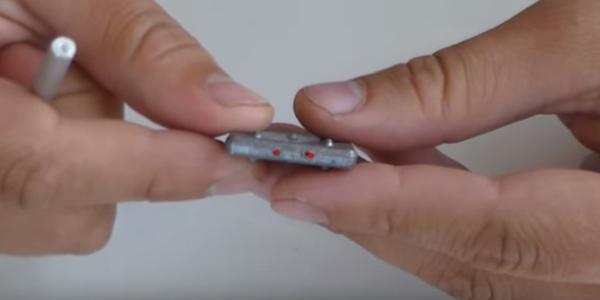
Rice. 1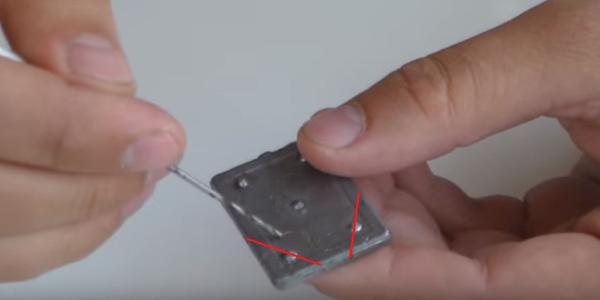
Rice. 2 - Then we cut off a piece of cord about 40 cm long (with a margin), and thread it through the holes, as shown in the photo. The end result should be a loop. Its size should be such that the cake is placed between the loop and the sinker.
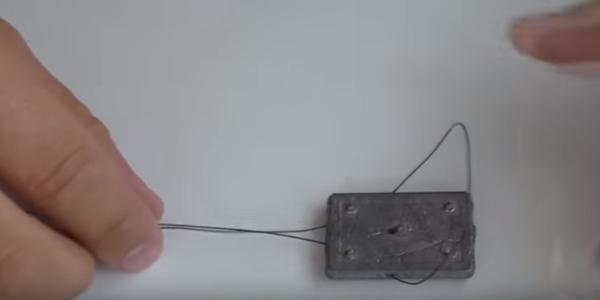
Rice. 3 - Now we take the silicone stoppers and drag them to the free ends of the cord. We move them symmetrically closer to the sinker.
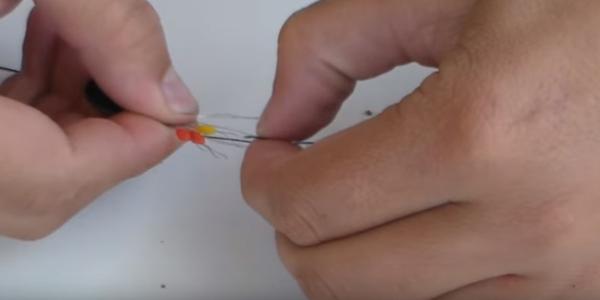
Rice. 4 - We tie the free ends into a loop, through which the feeding trough will be attached to the main fishing line using a fastener (Fig. 5).
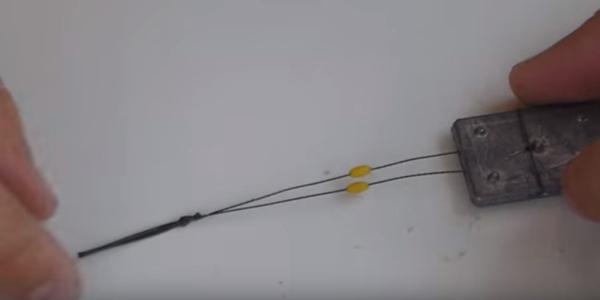
Rice. 5 - The next stage is making leashes. We cut off a piece of cord, about 25 cm long (with a margin), and tie two hooks to its ends (Fig. 6). Then we fold the leash in half and tie a loop a couple of centimeters from the bend.
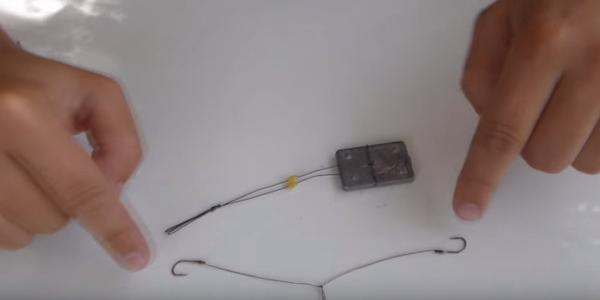
Rice. 6 - We attach the leashes to the loop with a noose knot.
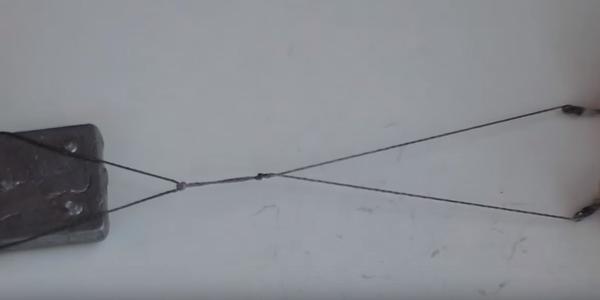
Rice. 7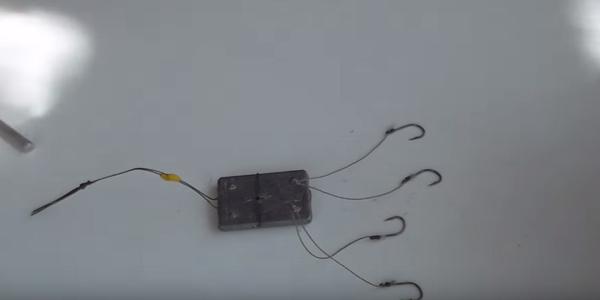
Rice. 8 - Installation is almost ready! All that remains to be done is to fix the crown cube with a loop (tightened, pressed with stoppers) (Fig. 9).

Rice. 9 - The final touch is to stick the hook tips into the top of the head (Fig. 10). That's it, you can catch carp!
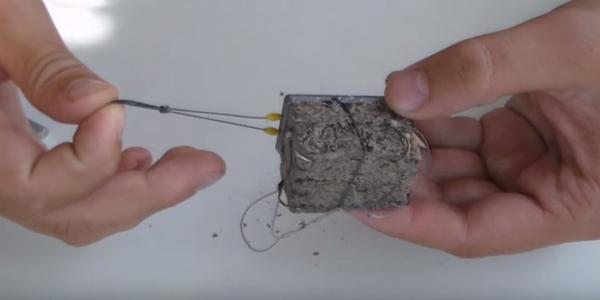
Rice. 10
DIY equipment for carp
Do-it-yourself tackle for carp is made according to the preferences of the fisherman. Let's consider one of the commonly used feeder equipment.
How to make:
- Prepare black beads and a small piece of fishing line (20 cm). We string beads onto it and bring them to the center of the fishing line. We knit and install the fasteners; it is better not to use knots.
- We make a twist 7 cm long. A swivel with a clasp and a crimping tube (more often used in spinning) are threaded through the end of the fishing line with beads. We twist it to the end and insert the tube. Attach the swivel to the loop and crimp the tube with pliers.
- We put the fishing line through the beads, while making a retraction that does not interfere with further procedures.
- We bend the fishing line after 20 cm, make a loop and attach it with a figure eight knot. To create a branch it is worth making a twist.
- We attach the feeder to the outlet. Attach a leash with a hook to the loop.
Tackle for catching carp from the shore - feeding
Without proper feeding, you will never catch a carp (unless by accident). Therefore, when going fishing, you need to stock up on a sufficient amount of bait mixture. In order to keep the carp at the fishing point, you really need a lot of bait.
The carp is very voracious; it literally sweeps away edible particles from the bottom. The bait mixture must contain high-calorie, large and heavy fractions.
It is difficult to find something similar among store-bought baits, so it is best to make a mixture at home using boiled pearl barley, pickled corn, and steamed peas as a base. For flavor, crumbly sunflower cake or garlic or anise flavorings are added to the bait.
River fishing gear
Whatever tackle an angler chooses for catching carp, it must be extremely durable and reliable. When assembling a fishing rod, it is necessary to carefully make knot connections, check the integrity of the fishing line and leash, and carefully inspect the hooks and swivels. Trophy fish does not forgive negligence and inattention. If you can catch small carp with any float or bottom tackle, then when catching large fish, the range of suitable fishing rods is significantly reduced. For coastal fishing, you can select a feeder and traditional donks. You can successfully fish from a boat using an onboard or Bolognese fishing rod. 1. Feeder tackle is in many ways similar to a carp fishing rod. It includes a powerful feeder rod 3.6-3.9 m long with a test load of up to 120 g. A reel with a 3500-5000 spool must have a baitrunner. Otherwise, even a reliable stand will not prevent the loss of gear. A braided cord with a breaking force of up to 20 kg is suitable as the main fishing line. The equipment and leash are selected according to the fishing conditions. 2. Such traditional donks as “nipple” and “makushatnik” are considered primitive, but effective. They are based on inexpensive fiberglass spinning rods about 3 m long. The rod is often equipped with an inexpensive but reliable Neva reel. Monofilament fishing line with a diameter of 0.5-0.8 mm is suitable as a base. Leashes made of 0.3-0.5 mm fishing line are attached directly to special equipment for catching carp. 3. A side fishing rod is an analogue of a feeder, only the rod is chosen to be short. Some fishermen attach a nod to the tip in order to see a bite before the carp begins its sprint swim. Since the bait is lowered near the boat in a large mesh feeder, the rig uses a sinker instead of a feeder. 4. The Bolognese fishing rod is in demand among ardent supporters of float fishing. The rod is equipped with an inertial reel that can rotate under the influence of the current. The equipment consists of a 0.4-0.5 mm monofilament line, a float, a sinker and a leash with a hook. Recommendation! The equipment must float exactly along the bait train. Then the fish will confidently grab the naturally floating bait.
Fishing
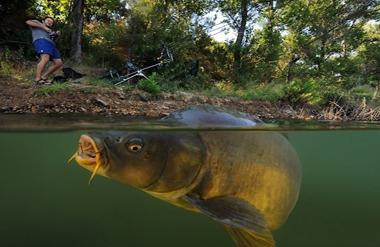
However, this is only half the story. The trophy still needs to be dragged to the shore and picked up. When fishing for carp, the most important thing is not to force events and not to try to seize an advantage from the first seconds of the fight.
First you need to tire out the river hero by letting him walk on a stretched fishing line. Rewind the cord when you feel weak. If the enemy is “rushing like a tank,” give up the cord.
When the carp gets tired, you can begin to confidently drag it to the shore. Ask your partner to pick up a landing net and go as far into the water as possible.
Bring the fish into the landing net slowly, and be prepared for the carp to make its last desperate push.
Often it is this that ends in an unfortunate gathering. Therefore, lower the clutch a little so that if something happens, the fish does not tear the equipment. No tail, no scales!
